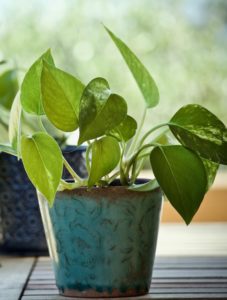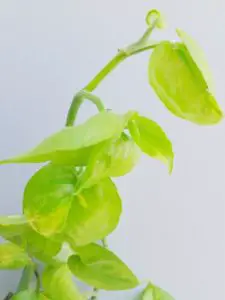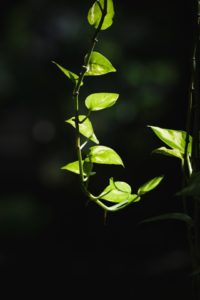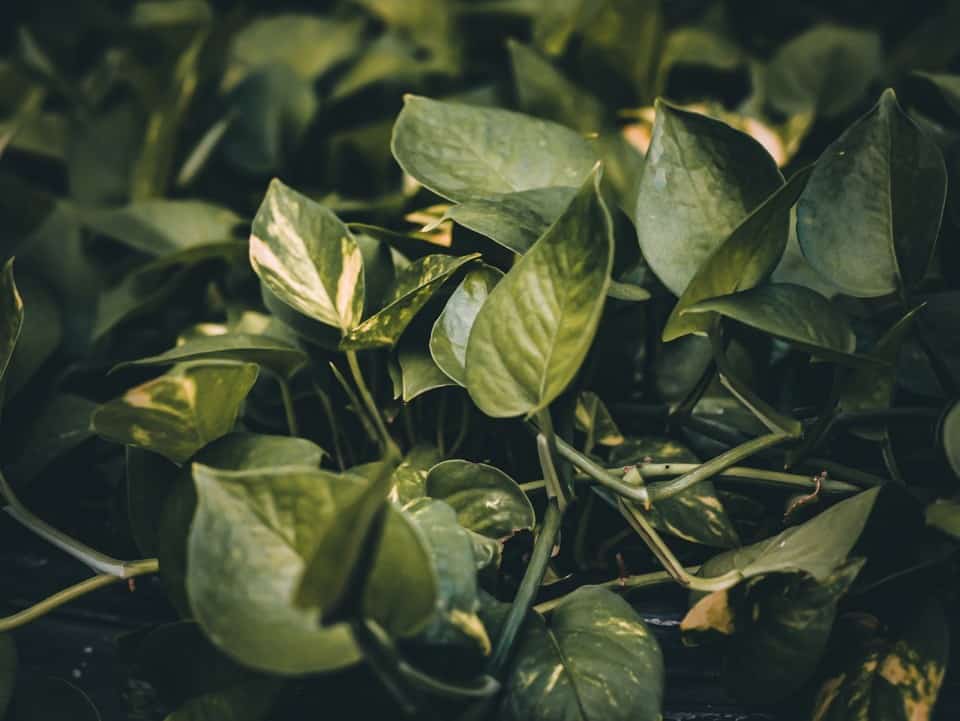Some links in the post are affiliate links and I get a commission from purchases made through some links found in the post.
Many people get confused between the Pothos and the Scindapsus. As both plants share a few characteristics.
But Pothos and Scindapsus have major and as well as minor differences. Sometimes, it’s hard to differentiate between the two. But with the right pointers, you can easily identify the difference.
Scindapsus and Pothos belong to the same family, “Araceae” but have a different classification.
The scientific or botanical name of Scindapsus is “Scindapsus pictus” while Pothos is known as Epipremnum aureum. Scindapsus has thicker leaves, a shiny outlook, and a grey texture mixed with darkish green.
On the contrary, Pothos has thinner leaves (compared to Scindapsus), smooth texture, and yellow-green leaves.
Let’s take a look at the similarities, differences and the type of Pothos and Scindapsus below!
Keep reading to find out everything about these plants so that you don’t confuse both plants. Although there are many similarities in both these plants there are also many differences!
Pothos vs Scindapsus – What are the Similarities?
 There are many things common between Pothos and Scindapsus that’s why some people easily get confused. For instance, these things are common in both plants:
There are many things common between Pothos and Scindapsus that’s why some people easily get confused. For instance, these things are common in both plants:
- Growth requirements
- Watering requirement
- Light requirement
- Soil requirements
- Toxicity
Let’s discuss each of the factors in detail for better clarification.
Quality of light
Both Pothos and Scindapsus require bright light. But the direct sunlight can damage the ever-green foliage – color distortion.
To have the perfect shape and color of both plants, you can put a cloth or curtain or place your plant under a shade to have your perfect plant!
Temperature and Humidity
Pothos and Scindapsus both are humidity sensitive. Both require 40% to 50% humidity for ideal growth. On the other hand, high humidity can also damage the Pothos and Scindapsus.
Pothos and Scindapsus require 65–85-degree Fahrenheit (18-29° Celsius) for ideal growth. The low temperature might cause dry damage in Pothos and Scindapsus.
Watering
Pothos and Scindapsus have the same water requirements. Neither grow well in overwatered, nor in fully dry soil. If the soil is damp constantly it will damage the roots of the plants.
Pothos and Scindapsus both grow well if you give some time between watering the plants. Pothos and Scindapsus share this characteristic due to their same family origin.
For both the pothos and the Scindapsus you should water them once every 1 to 2 weeks to keep them happy.
You may also like: How to save an overwatered pothos
Soil
Pothos and Scindapsus both grow ideally in potting mix. This includes nutrients which help them to grow at an ideal rate.
Moreover, both plants can grow in neutral to acidic conditions. But Pothos has a high tolerance of soil pH as compared to Scindapsus.
Pothos and Scindapsus do not shoot up in wet and fully moist soil. Both plants require half or low moist soil for proper growth.
Toxicity
Pothos and Scindapsus will look beautiful wherever you place them, however you need to make sure of one thing, that your pets should not swallow them.
If they swallow this either the Pothos or the Scindapsus, it can be dangerous to them. Cats and dogs should stay away from these plant since you might see some irritation around their lips and tongues.
Hence, it is not safe to have both plants if you have pets around.
If you are enjoying this article, check out our article on pothos vs monstera
Pothos vs Scindapsus – What are the Differences?
Although both pothos vs Scindapsus belong to the same family they are still different in many forms. Both plants are completely different concerning:
- Shape
- Length
- Color
- Stem
- Leaves
- Flower
- Growth
- Fertilizer
Let’s take a detailed look at all these factors. This will also help you to see the difference between Pothos and Scindapsus.
Leaf Texture
Scindapsus has a grey texture mixed with green color. There is a particular color pattern of grey and green in Scindapsus.
The shade of grey varies from one variety of Scindapsus to another. Moreover, Scindapsus leaves are thick and wide in appearance.
On the contrary, Pothos covers almost all shades of green. Pothos carry dark, neon, and bright green colors. The color pattern of Pothos is usually plain. Pothos have thin heart-shaped leaves.
Growth
Pothos and Scindapsus both sprout tall in their natural habitat. But both have different growth rates. Pothos growth rate is slightly higher compared to the Scindapsus.
Pothos grow up to 12-18 inches every month in summer and spring, unlike Scindapsus.
The mature growth size of the Pothos is twenty to forty feet while Scindapsus’ mature growth size is four to ten ft.
Both plants are difference in their length and through that, you can easily identify them. The reason for less growth in Scindapsus is the less amount of chlorophyll.
Scindapsus has less green and greyer, unlike Pothos. The green part of the leaves helps them to grow fast.
Stem
As Scindapsus leaves are thick in texture, similarly their stems are also thick and strong.
Scindapsus stems are dark green and look amazing with grey-green leaves. On the contrary, Pothos stems are thin and are balanced with their thin leaves.
Pothos stems give a compliment with a two-color shade. Stems of Pothos are yellow-green or neon green in color. The thickness of the stem helps you to identify the difference in both plants.
If your pothos is developing brown stems we have an article on how to save your pothos from having brown stems to help you.
Flower
Scindapsus do have flowers, but they are very small and unobservable. They grow in summer and are green in color. Unlike Scindapsus, Pothos do not have flowers.
Now you might see that it is easy to identify the plants. Sometimes but only in rare cases, Pothos grows flowers. But they grow in different colors. As you will observe them in purple, lavender, or green.
Fertilizer
Pothos is a tropical plant and requires no special fertilizers. You can add houseplant fertilizer for ideal growth once or twice a month.
On the other hand, Scindapsus needs a full package of water-soluble houseplant fertilizer when the growing season comes that is during summers.
You may also like: Pothos N joy vs pearls and jade
Pothos vs Scindapsus – Where is the best place to plant them?
 If you are looking for an indoor plant, then Pothos is the best option. You can plant Pothos in bright or indirect light.
If you are looking for an indoor plant, then Pothos is the best option. You can plant Pothos in bright or indirect light.
For instance, you can grow pothos near the window of your kitchen, bathroom, offices and put a curtain or anything between the sunlight and the plant.
Secondly, you can plant Pothos in a vase or pot as this plant takes less space to grow. Lastly, you don’t need to do extra care or to buy special fertilizers for Pothos.
Right temperature and light will be enough for their ideal growth. With direct light and wet soil, the plant will not thrive properly. It will distort the color and growth of the Pothos.
Similar to Pothos, you can plant Scindapsus in dry soil or moist soil in a pot. You can place this plant in a shady place or indirect light.
The direct light will cause wilting in the plant. For best growth, you need rich and well-drained soil for the plant and watering the plant when you see that soil is dry about 2-3 inches.
Indoors, you need to put the vase near the window or outdoors, you need to put it somewhere away from the sunlight. But make sure, you are placing the plant near the source of indirect light.
Pothos vs Scindapsus – How many varieties are there?
Scindapsus Pictus Varieties
Scindapsus has many varieties and some of them are common while others are rare to find. The top 6 and common varieties are listed below.
Scindapsus pictus variety of ‘Exotica’
Exotica is one of the common varieties of Scindapsus as it has large and wide thick leaves and steps.
The green color is polished around the leaves and in the centerline of the leaf and the rest of the area is filled with grey.
Scindapsus pictus variety of ‘Silver Satin’
Silver Satin is the most common variety. This variety has less variegation than Exotica. Other than the plant it almost resembles the Exotica.
Scindapsus pictus variety of ‘Silvery Anny (Ann)’
Silvery Anny has small leaves as compared to the Exotica. And easily identifiable.
These plants have very little variegation of green and grey. But few leaves out of many in the same plant are full grey or polished in grey.
Through their unique variation in color pattern, you can easily identify them.
Scindapsus treubii variety of moonlight
The Scindapsus treubii moonlight is the rarest variety of Scindapsus and is difficult to find in stores but available online and you can also get them through vendors.
Moonlight is famous due to its unique color of grey. The upside of the leaves is full grey and shiny.
The down area of the leaves also has a grey shade mixed with green color. It is one of the best varieties for indoor decoration.
Scindapsus treubii variety of dark form
The dark light of Scindapsus is opposite to the moonlight. Scindapsus treubii dark form has dark green leaves. They are less wide and longer in shape.
Scindapsus pictus variety of platinum or silver hero
Some research suggests that platinum and silver are different plants however, some believe they are two names of one plant.
Both plants have full grey leaves with the light tone of green sometimes, green color completely absent in these plants. Silver hero has matte and greyish leaves while Platinum has shiny and more greenish-grey leaves.
Pothos Varieties
There are lots of pothos varieties available in the market. The exact number of varieties is unknown. The most common and easily available varieties of Pothos are discussed below.
Manjula pothos
Manjula Pothos has heart-shaped leaves and curls at both tips. The color of the leaves varies from white to green, silver to green, and cream to green. This plant looks incredible with the modern indoor setting.
Golden pothos
This variety is the main representative of the plant. The plant name is Golden Pothos, but the leaves are in green color, specifically emerald, green shade. Some leaves might have a slight touch of yellow or cream color.
Marble queen pothos
Epipremnum Aureum variety of Marble Queen is the most common and popular kind. You can indicate its design through its name.
It has a marble-like pattern on the leaves in white and green color. In one plant, you might find some leaves with more white and less green as well as less white and more green leaves. This type of variation exists within one plant.
Neon pothos
Neon Pothos has perfect heart shaped leaves in shiny neon colors. This plant is easily detectable due to its sheen-green appearance.
The young Neon Plant usually has dark green leaves, but it changes to neon green when it gets mature.
Cebu blue pothos
Cebu Blue Pothos are different from the other varieties of Pothos. This plant has arrow-shaped leaves in blue green the ratio of the blue color is almost zero in the leaves. The leaves have a sharp edge which is open-ended.
Final Thoughts: Pothos vs Scindapsus
 People usually get confused between Pothos and Scindapsus due to the almost similar names.
People usually get confused between Pothos and Scindapsus due to the almost similar names.
Scindapsus is also famous or known as silver pothos and satin pothos. Due to the name “Pothos” people automatically conclude that both are the same plants or belong to the same kind.
The other reason that people get confused is due to the similarities between the Pothos and Scindapsus’ kinds or varieties. Some of the Scindapsus varieties are very similar to Pothos in appearance which confuses people.
Pothos and Scindapsus both are different in their habitats, appearance, and growth. But both plants are best for indoor planting and give compliments to the indoor environment.
The care and growth of both plants are trouble-free. It is very easy to plant them in your house or your workplace. Pothos and Scindapsus are toxic to pets especially dogs and cats, but it is not that they kill your pet.
Pothos vs Scindapsus are great indoor plants that will grow perfectly well in any condition.
They are a low maintenance plants that do not require too much attention from its owners. So, whether you’re a beginner or an experienced gardener in my opinion this plant might just be the option you’re looking for!
Before you go, here are some more related articles I encourage you to read below to help solve more of your gardening issues:

